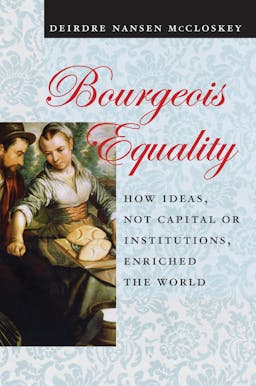
Book Review
Bourgeois Equality: How Ideas, Not Capital or Institutions, Enriched the World, 2016
By Deirdre Nansen McCloskey
Bourgeois Equality is the last part of Deirdre Nansen McCloskey’s trilogy on the vindication of the bourgeois ideology, together with The Bourgeois Virtues (2006) and Bourgeois Dignity (2010). With this series, the Emerita distinguished professor of Economics and of History, and professor of English and of Communications, at the University of Illinois at Chicago persuasively describes and supports what is considered modern capitalism.
According to McCloskey, the clerisy has been casting doubts -mostly based on emotional and utopian reasons- against modern economic growth. Also, many scholars have been offering mistaken theories (institutions, capital accumulation, imperialism, geography, etc.) for the causes of the current Great Enrichment. The author, rather, points to the worldwide spread of an ideological change: the shift to the so-called Bourgeois Era, whereby economic betterment is seen as honourable by a society.
The key is the eventual attainment of liberty and dignity for the commoners, ordinary people, through “trade-tested betterment resting on a new equality in the eyes of others” (40). This is why McCloskey does not interpret the word equality as “equal distribution of material income”, but as a Smithian “egalitarian opinion people have of each other” (XXXI).
Ideas are ethical valuations, and the latter are often carried by words, rhetoric, and persuasion. Supported by an extraordinary command of references on economics, history, philosophy, sociology, literature, art, and linguistics, McCloskey identifies the ideas about the bourgeois betterment and depicts their dramatic expansion over time.
Europe’s ideological change in the Bourgeois Eracan be reconciled with the cultural evolution that, according to Philip T. Hoffman (2015), spread new norms of behaviour and caused Europe’s political fragmentation. Western Christianity, heir of an enduring culture originated in ancient Greece and Rome, seems to have played a significant role in providing a common basis for morality and for law. This, in turn, would have led to a certain intellectual and economic freedom, and the subsequent redemption of the bourgeois life. In fact, McCloskey mentions the development of a Democratic Church, as opposed to a Church of Power and its collaborative monarchs, which emboldened people in politics and the economy.
It seems clear that the virtues linked to capitalism and the Christian Reformation were not new. The author believes that the shift from a happiness of heaven to a happiness of earth came from Holland and England around 1700 (410). But, if seventeenth-century Holland served as a model for the later English and Scots of how to talk about being bourgeois, who served as a model for the Dutch? McCloskey accepts that French, Dutch, and English theorists of politics in the seventeenth century owe a good deal to the libertarian pioneers of the sixteenth century’s scholastic tradition (340). In fact, essential notions of economic liberalism such as natural human, economic freedom appeared first in scholastic Spain (383). One of the big names at the time was Juan de Mariana (1536-1624). A recent book by Fernández Álvarez (2017) gathers evidence on the enormous influence of Mariana’s writings (especially, De Rege et Regis Institutione and De Monetae Mutatione) in the new ideas of protestant moral philosophers (Grotius, Pufendorf, Locke), as well as in those of the founders of the United States of America (John Adams).
Another point of interest is finding proofs, as McCloskey does, on the origins of the Bougeois Era, which seems to have well begun between 1600 and 1848 in North- Western Europe. I would argue, however, that more signs of evidence are needed, especially for the Early Precocious Period. Obsession with accurate counting and public calculation, for example, are put as signs of common prudence, one of the middle-class virtues and characteristic of the bourgeois world. The author cites the case of the Dutch mathematician Simon Stevin (1548-1620) who persuaded the city of Amsterdam and the Swedish king to adopt double-entry bookkeeping (270).
Well, in sixteenth-century Castile, some of the Toledo Cathedral’s canons belonged to merchant families in the city. One of them, Gutierre Hurtado, was responsible for introducing the double-entry bookkeeping in the Chapter’s ledgers (1533-1539). In this case, the new accounting system was implemented in Toledo’s biggest religious organization from the civil and commercial sphere, a decade before Simon Stevin was born. Does that mean that the city’s bourgeoisie was not then precocious. Unless more systematic information is collected on this issue in other parts of the continent, the argument looks controversial.
That being said, one of the great challenges set out by McCloskey’s bourgeois trilogy is the need for a reassessment of the big questions of economic history. The author maintains that economic historians and their students should stop their continuist focus on the relatively modest rising incomes in Europe between 1100 and 1800, and start asking why betterment was so much higher after 1800 than in earlier times. McCloskey has again written another book to encourage further research on alternative topics in economics and business history. Her suggested tool for that purpose is the study of world bourgeoisies. And especially a study of the attitudes of the various societies to the betterments proposed by their respective bourgeoisie (484).
David González Agudo
University of British Columbia